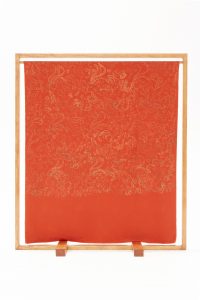One Way Amorphous Road, 2020
melted wax drawing, fabric dye and ink on silks and linen, pine wood standing frames with oil tinted varnish
dimensions variable
image courtesy Dirham Gama Radityo and the artist
Rozana Lee explores the way global histories and cultural identities are woven into textile aesthetics, production and trade. Using the visual language of Indonesian Batik, she creates sumptuous hanging forms containing motifs that portray the complex history of fabric production and relationships. Batik emerges from the Javanese word “ambatik” which means “a cloth with dots”. While closely associated with the Malay Archipelago, the fabric has many variations including Dutch resin-resist print, a fabric inspired by Indonesian batik, but mass manufactured in Holland for export to West Africa where it now is an important element of African culture and identity. Lee draws upon research like this to inform her practice.
After sketching different designs and patterns, Lee draws these patterns using hot beeswax applied using a Tjanting — a fountain pen-like tool with a small copper cup and a tiny spout. The fabric is then dyed one colour at a time, depending on the design. The wax acts as a resist, protecting the drawn patterns from absorbing the colour. The installation One Way Amorphous Road (2020) extends Lee’s practice in reframing textile traditions. While these signs and symbols may not be immediately clear to lay audiences, they contain appropriated and recontextualised imagery and altered process that is known to those privy to these cultural signifiers. In this way, Lee’s work function as an anti-archive that prompts audiences to re-evaluate and question the notion of originality in cultural identity in the post-colonial era, as well as the economic, social and political circumstances which have marginalised non-Western art and craft traditions.
– Micheal Do
*
FROM THE ARTIST
My practice looks at my personal relation to South-East Asia, its connection to Aotearoa New Zealand, and the political and material histories connecting these countries together.
I’ve made colourful Batik fabrics to form an installation. This gives me the freedom to hang the fabrics from the ceiling, draped across free-standing frames or spread out on the floor. My chosen method of drawing using traditional pen-like tool for applying hot wax onto the fabric speaks about my Indonesian cultural heritage. In the past, ornamental patterns described a tribe to itself or to other tribes. They now tell a story of my navigations across and between cultures.


